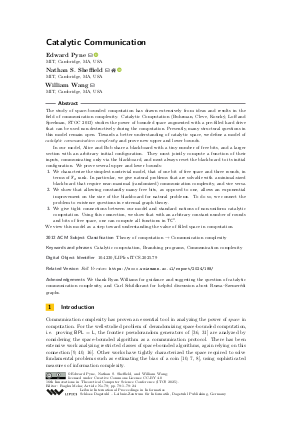LIPIcs.ITCS.2025.79.pdf
- Filesize: 0.9 MB
- 24 pages

 Creative Commons Attribution 4.0 International license
Creative Commons Attribution 4.0 International license

The study of space-bounded computation has drawn extensively from ideas and results in the field of communication complexity. Catalytic Computation (Buhrman, Cleve, Koucký, Loff and Speelman, STOC 2013) studies the power of bounded space augmented with a pre-filled hard drive that can be used non-destructively during the computation. Presently, many structural questions in this model remain open. Towards a better understanding of catalytic space, we define a model of catalytic communication complexity and prove new upper and lower bounds. In our model, Alice and Bob share a blackboard with a tiny number of free bits, and a larger section with an arbitrary initial configuration. They must jointly compute a function of their inputs, communicating only via the blackboard, and must always reset the blackboard to its initial configuration. We prove several upper and lower bounds: 1) We characterize the simplest nontrivial model, that of one bit of free space and three rounds, in terms of 𝔽₂ rank. In particular, we give natural problems that are solvable with a minimal-sized blackboard that require near-maximal (randomized) communication complexity, and vice versa. 2) We show that allowing constantly many free bits, as opposed to one, allows an exponential improvement on the size of the blackboard for natural problems. To do so, we connect the problem to existence questions in extremal graph theory. 3) We give tight connections between our model and standard notions of non-uniform catalytic computation. Using this connection, we show that with an arbitrary constant number of rounds and bits of free space, one can compute all functions in TC⁰. We view this model as a step toward understanding the value of filled space in computation.













Feedback for Dagstuhl Publishing